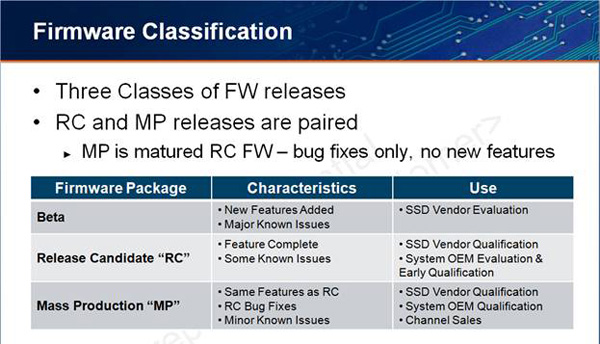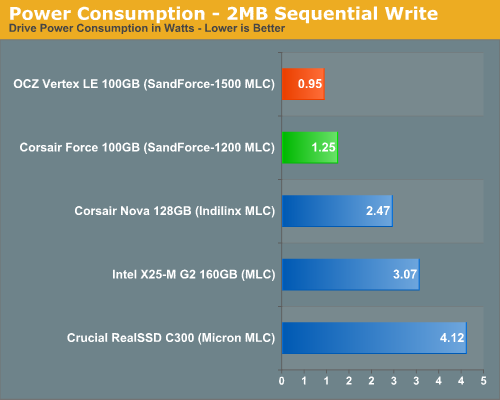Understanding SandForce's SF-1200 & SF-1500, Not All Drives are Equal
by Anand Lal Shimpi on April 16, 2010 11:30 AM ESTIt’s a Mad World: Not All SF-1200s Perform Alike
OCZ was the first from our community to really embrace SandForce. It’s my understanding that the two companies have a very close relationship, and OCZ has committed a lot of resources to SandForce and its products. OCZ took the early risk that others would not. While other companies are working with SF today, OCZ appears to have been the first from the SSD makers we cover on the site.
In exchange for their cooperation and support, SandForce gave OCZ a couple of things. First was the unique SF-1500 used in the Vertex LE at competitive prices (and minus some of the enterprise features). This gave OCZ a huge head start on the competition. The second thing SandForce gave OCZ was the rights to an exclusive firmware for the SF-1200. This firmware would give OCZ the small file random write performance of the SF-1500, but with the rest of the feature set of the SF-1200. This special firmware is going to be used in the upcoming Vertex 2 SSD.
The rest of SandForce’s customers would get the standard SF-1200 firmware, which allows the drive to run at 10,000 sustained 4K random IOPS. Other SF-1200 drives from OCZ, such as the upcoming Agility 2, would also use this standard SF-1200 firmware. The special firmware is only for the Vertex 2 at this point.
SandForce’s firmware has been in release candidate (RC) stage for the past couple of months. Internally SandForce calls this version 3.0.1 and has communicated to all of its partners what RC vs. MP (mass production) firmware entails:

This slide is shared with all SF partners.
Two things are true about this RC firmware: 1) it doesn’t limit small file random write speed on the SF-1200, and 2) there is a known reliability issue that could result in a dead drive (similar to what happened to my Vertex 2 Pro earlier this year).
And here’s where things get messy. SandForce distributed 3.0.1 to all of its partners (so much for that exclusivity agreement), and some of its partners have decided to sample reviewers or even ship based on 3.0.1. Note that even OCZ’s Vertex LE shipped using the SF-1500 version of this firmware. If SandForce indeed distributed the above slide to all of its partners, no drive should've shipped with RC firmware. That's a separate issue entirely and I've been working with both SandForce and the companies involved to see what we can do about curbing this (or at least get me the information so that I can make it clear when a product is using non-MP firmware).
The Corsair Force drive that has been sent out for reviews and that’s currently shipping today uses SandForce’s 3.0.1 firmware.
Naturally, I called up Corsair to figure out what’s going on. Corsair explained to me that the reliability problem was related to a power saving feature on the controller that Corsair simply disabled and thus avoided the issue entirely. I have yet to find a repeatable way to reproduce the bug, but the power data from our testing corroborates what Corsair is saying:

Corsair’s drive uses more power than OCZ’s Vertex LE. While it could be for a number of reasons, it’s apparently due to this power saving feature being disabled. Unless I’m wrong, Corsair appears to have circumvented the known reliability issue and is shipping product it feels is safe into the market.
Now we get to the other problem. The performance of 3.0.1 is the same as OCZ’s exclusive SF-1200 firmware, because the firmwares are the same. However SandForce has recently released its first MP firmware: 3.0.5. This firmware, as you’d expect, caps small file random write performance on all SF-1200 drives except for the Vertex 2 in accordance with SandForce’s agreement with OCZ. The SF-1500 version of this firmware doesn’t change performance, but it does supposedly fix the reliability problems and is available for Vertex LE owners here.
Corsair is currently testing the 3.0.5 revision for its drive but hasn’t shared it with me yet. Corsair wasn’t aware that performance dropped with this revision until I called yesterday. The release notes don’t indicate anything of the sort, Corsair was kept completely in the dark on this. Why didn’t SandForce tell Corsair? Because although it drops performance, the new firmware still runs the SF-1200 at its intended spec. The chip will continue to perform as advertised, just slower than with the RC firmware and slower than OCZ’s Vertex 2.










81 Comments
View All Comments
_Q_ - Saturday, April 17, 2010 - link
Sorry for being a little off-topic (still SSD though)...Are there any news on when is the Indilinx JetStream going to be released in some drive from any vendor?
Cause as far as I know, this was initially going to be out in end of 2009, then there was a delay... but no further info that I could find more recently.
Thanks for any help.
1921Photoelectric - Saturday, April 17, 2010 - link
What this says to me, companies will re-write firmware to get the competitive edge. Also it will spur on hacked firmware to get the most out of the drive and than don't forget cross flashing, being blocked or not it will be circumnavigated. Been doing that with cd\dvd burners for quite some time. The one big downturn in this is, unscrupulous relabeling of the controller chip. This use to happen with CPU's a lot before Intel and AMD started locking the chips.Movieman420 - Saturday, April 17, 2010 - link
SandForce is the sole FW coder...;)shawkie - Saturday, April 17, 2010 - link
I've just posted a comment on the previous article on this subject but I thought it might be worth repeating it here. I've taken a look at the source code for the 2008 build of IOMeter and I don't think it should be trusted to produce realistic benchmarks for SandForce drives. The problem is that the data written to the disk is not sufficiently random and as a result will be very highly compressed by the SandForce controller.velis - Monday, April 19, 2010 - link
I think this deliberate FW throttling is a load of c**p.Sandforce is hurting its own sales by doing this. While before I liked what was said about these controllers, now I only see a deliberately crippled *and* overpriced chip. IMHO this is just as bad a business practice as when Intel decided to lock processor multipliers. With an unimportant exception that Intel could certainly afford it as they were more or less a monopoly then as they are now. SF on the other hand is a startup...
It doesn't really matter that real life performance won't be affected much by this. It's the thought that counts!
They should offer a really good explanation for this throttling or give their customers something in return (an extra SF-1200 only feature). As it is, hacked FW will be all over the net, assuming of course that anyone will be buying these drives at all.
ToeCutter - Saturday, April 24, 2010 - link
I couldn't agree more. Artificially reducing performance just fails the smell test.And while the performance numbers look impressive, the usable capacity numbers don't.
Oh well, looks like the Intel SSDs are the only reliable game in town.
It has been kinda nice not having to worry about which SSD to buy for the past couple of quarters?
Sometimes it seems that choice, just for the sake of choice, can be a pain in the ass more times than not!
lemonadesoda - Tuesday, April 20, 2010 - link
"Your best bet at this point is to hold off on any SF-1200 purchases unless you're willing to accept the risks that comes with."I agree with you 100%. But I'm sure SandForce never realised that inviting you to their meeting would result in you discovering their mismanagement of firmware, specs and partner relationships.
Not so sure they will be inviting you again. At least, not before you sign some "right to review copy" NDA or somthing. LOL ;)
ToeCutter - Saturday, April 24, 2010 - link
I'd like to extend a hearty "THANKS!" to Anand for demonstrating his values on this topic. As a storage engineer working for a reputable vendor, I understand first hand how much pressure can be exerted on engineers to "overlook" certain aspects of a products behavior.I can say, with a degree of pride, that I've always played it straight with my customers, even when hurt. And they rewarded me for maintaining my credibility with repeat business and friendship, which is so much more important to me than making a few extra bucks.
Kudos to Anand for keeping everyone honest. While it might seem like "geek drama" to the uninitiated, Anand said it when he explained to these vendors that "this is serious, it's our DATA"!
Well done, Mr. Shimpi.
Hrel - Saturday, May 8, 2010 - link
Basically, SSD's aren' ready for the mainstream yet, there's apparently a LOT of stuff that needs to be worked out before that can happen, not to mention the insane cost per GB. Also, when are people gonna really start making a fuss about companies "artificially" reducing performance. Like disabling cores that are fully functional then selling the CPU at a lower price. The sale price of a product should be based on what it costs to make, I shouldn't have to pay a premium for a chip just because some features aren't locked. Intel does this all the time and it seriously pisses me off. What's the physical difference between an E8400 and and E8600? nothing! They're just clocked different yet one costs more than the other even though they cost the same to make. Same thing with GPU's. It's maddening!TheRealAnalogkid - Friday, June 4, 2010 - link
Kudos to Anand and his journalistic talent (not a term frequently used online) to not only discover but to expose this.I've read his site for many years and this is one of the best articles I've seen. Keep up the good work.